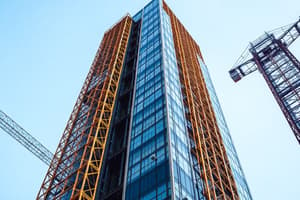Podcast
Questions and Answers
What were the two key innovations that enabled the construction of skyscrapers?
What were the two key innovations that enabled the construction of skyscrapers?
The steel frame and the elevator were the two key innovations.
What was unique about the construction technique used for the Monadnock Building?
What was unique about the construction technique used for the Monadnock Building?
The Monadnock Building used load-bearing walls that were seven feet thick.
How did Elisha Otis's invention of the safety elevator impact skyscraper construction?
How did Elisha Otis's invention of the safety elevator impact skyscraper construction?
Otis's safety elevator made it practical for people to access tall buildings without climbing stairs.
Describe the construction process of the Sears Tower in terms of its timeline and materials used.
Describe the construction process of the Sears Tower in terms of its timeline and materials used.
What challenges did workers face during the construction of skyscrapers like the Sears Tower?
What challenges did workers face during the construction of skyscrapers like the Sears Tower?
What significant event occurred by May 3, 1973, related to the Sears Tower?
What significant event occurred by May 3, 1973, related to the Sears Tower?
In what year was the Sears Tower officially renamed to the Willis Tower?
In what year was the Sears Tower officially renamed to the Willis Tower?
When did Sears Roebuck and Company sell the building, and what did the name remain until?
When did Sears Roebuck and Company sell the building, and what did the name remain until?
What was the height of the Sears Tower, and how long did it hold the title of the world's tallest building?
What was the height of the Sears Tower, and how long did it hold the title of the world's tallest building?
Why did the Willis Group Holdings decide to rename the Sears Tower?
Why did the Willis Group Holdings decide to rename the Sears Tower?
Flashcards
Steel frame skyscrapers
Steel frame skyscrapers
Skyscrapers using steel skeletons or steel-reinforced concrete for support, allowing them to rise much higher than buildings with load-bearing walls.
Load-bearing walls
Load-bearing walls
Walls that support the weight of the building's floors and roof directly.
Safety elevator
Safety elevator
An elevator that has safety mechanisms to prevent accidents, making tall buildings more practical.
Sears Tower construction
Sears Tower construction
Signup and view all the flashcards
Construction challenges
Construction challenges
Signup and view all the flashcards
Sears Tower Renamed
Sears Tower Renamed
Signup and view all the flashcards
Willis Tower Lease
Willis Tower Lease
Signup and view all the flashcards
Sears Tower Height
Sears Tower Height
Signup and view all the flashcards
Sears Tower Ownership
Sears Tower Ownership
Signup and view all the flashcards
Branding Strategy (Willis Tower)
Branding Strategy (Willis Tower)
Signup and view all the flashcards
Study Notes
History of Skyscrapers
- Early skyscrapers emerged due to growing American businesses needing centralized urban locations.
- To remain in city centers near rail and ports, buildings needed to grow vertically, rather than horizontally.
- Key innovations enabling skyscrapers:
- Steel frames and steel-reinforced concrete supported the weight of many stories.
- Improved elevators (safety) made tall buildings viable and practical.
- The Monadnock Building (1891), an example of a tall building with load-bearing walls, exemplified the limitations of this early approach. Its thick walls made it unworkable for taller buildings.
Construction of the Sears Tower
- Construction of the Sears Tower (later Willis Tower) took roughly three years and $175 million.
- The foundation was formed by laying 200 circular caissons into bedrock.
- Prefabricated steel sections (referred to as “Christmas trees”) were used for efficient construction, rising at about two floors per week.
- Construction used multiple derrick cranes for structural placement of steel sections.
- The sheer amount of concrete poured for the foundations and floors was enormous (enough to make an eight-lane five-mile highway), and special elevators were created to carry the concrete to high elevations.
- Special kitchens were built part way up the structure to accommodate the workers' needs and long work hours.
- Construction was significantly impacted by weather, especially strong winds.
- Construction was completed in May 1973, with workers' signatures placed on the final structural beam.
Sears Tower Renamed
- The Sears Tower was renamed the Willis Tower in 2009, when a London-based insurance company, Willis Group Holdings, leased a large part of the building for a significant portion of a decade.
- The renaming was for branding and to increase visibility in the US market by creating a brand recognition campaign.
- The structure and height remained the same, but was a new chapter for the now Willis Tower.
- The Willis Tower continued to hold an iconic place in Chicago's skyline and its history.
Studying That Suits You
Use AI to generate personalized quizzes and flashcards to suit your learning preferences.




